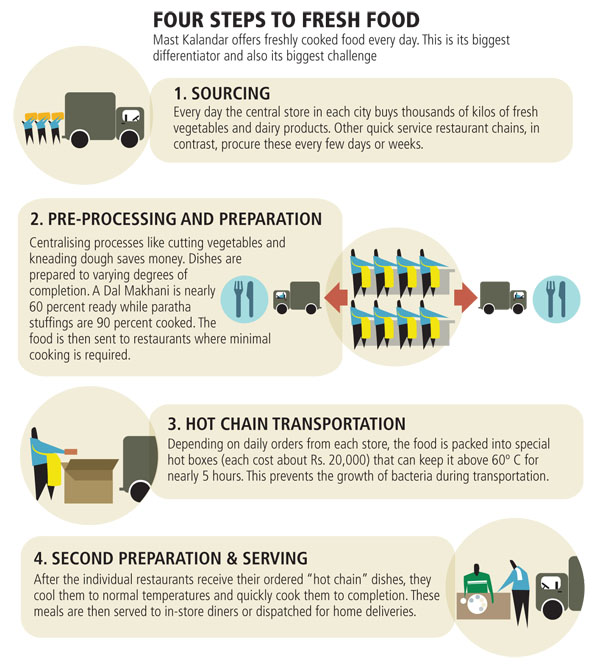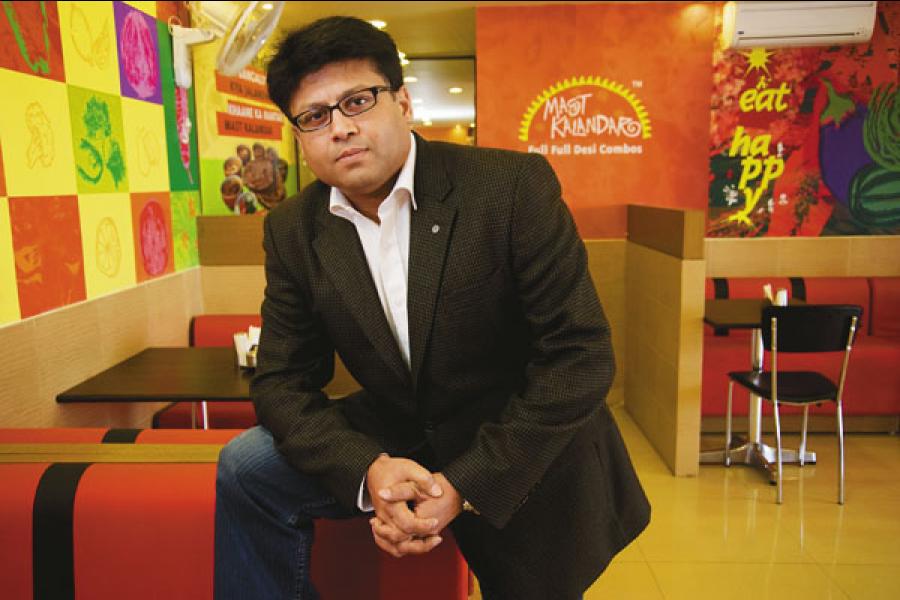
A North Indian Restaurant in South India
Pallavi and Gaurav Jain pulled a rabbit out of their hat by running a successful North Indian restaurant chain in South India. Now, they want to try their luck in the rest of the country
In February 2005, a group of 10 restaurant staff couldn’t believe their ears when they heard their new employers talk. They were standing in a stuffy, under-construction restaurant — to be called Mast Kalandar — in Bannerghatta Road, a Bangalore suburb, that would be their workplace when it was ready. But what the chefs, waiters and helpers were thinking was: Were their employers, a young couple, ready for the restaurant business?
“Because our food is going to be just like homemade food, we will use only quality ingredients we use at home, such as MDH spice mixes, Annapurna flour, sunflower oil or Amul butter and cheese,” said 34-year-old Pallavi Jain. “Our food costs will be higher than other restaurants by 10 percent,” said a chef. “We can’t sustain it.”
Gaurav Jain, 37, added, “We will cook all our lunch and dinner meals fresh, every day.” Another voice quipped back, “In hotels and restaurants, food is usually prepared once, cooled and then reheated when ordered. Cooking and serving everything fresh, two times a day, won’t work.”
Either the couple wasn’t grasping the gravity of the situation, or they were plain suicidal.
Then Pallavi said, “Oh, and we will not have deep freezers in our kitchens because we will only use fresh ingredients in our cooking, like in our homes.”
“You’re both mad,” said one of the staff, hoping his stark comment would probably knock some sense into the obviously inexperienced couple. “This won’t survive,” he said. The staff didn’t think that the Rs. 18 lakh, part of their life’s savings that the couple had sunk into the business, would pay off.He was wrong. In fact, the next year the couple opened a second outlet in Bangalore. Then a third, and a fourth. After a couple of years, the sunny yellow outlets even started popping up in Hyderabad and Chennai. Hard-nosed venture capitalists committed to investing serious money in the chain, nearly $5 million in all.
Today, Mast Kalandar has 22 outlets and a clear plan to reach 100 before the end of next year. And then, 500 more.
And all this using the almost bland cuisine positioning: “Authentic, vegetarian, homemade style North Indian food.” Wasn’t eating out all about escaping homemade food?
Homemade, but not at Home
Well yes, and no. Increasingly, there’s a new category of customers frequenting restaurants: They eat out or order in because they don’t want the hassle of cooking at home. They include working professionals who don’t have the time or knowledge for everyday cooking, or newly married working couples who don’t want to deal with dirty vessels, maids and grocery.
That is the primary market Mast Kalandar is targeting.
“We’d like to think of ourselves in the ‘home meal replacement’ category,” says Gaurav. He is from Uttar Pradesh and Pallavi, the company’s COO and food strategist, from Punjab. When their jobs got them to Bangalore, they started looking for regular eating out options, light on their stomachs and wallets. There weren’t many.
Things came to a head one day when, after a night of playing Scrabble with their friends, they decided to head out for an early lunch. “We couldn’t agree upon a single place that served North Indian food that all of us would like. So, we came back home and cooked khichdi instead,” says Gaurav.
That incident formed the nucleus for the Jains’ first outlet.
Cracking the Iceberg
A restaurant is like an iceberg. What the customer sees is only the tip. The real factors that are behind the success or failure of a restaurant are the ones behind closed doors: The complexity of preparing the dishes, the real estate costs, the supply chain for procuring and transporting ingredients across outlets or tweaks to the standard menu relative to local customer preferences.
Getting even one of them wrong can scuttle a restaurant’s chances of making it through the notoriously high rate of failure in the industry. Mast Kalandar’s business model rests on four key aspects.
Its decision to offer freshly cooked meals is both its biggest differentiator and its biggest execution risk. “Over 30 percent of our customers dine more than six times a month with us,” says Gaurav. The restaurants seat 55-60 people, who spend Rs. 80-100 per person on a meal. This adds up to Rs. 85 lakh to Rs. 90 lakh in revenue at one restaurant annually, delivering cash profits of 25-30 percent in steady state. With 22 outlets, this translates into revenues of Rs. 18.7 crore.
There are enormous demands on the kitchen and supply chain, especially in light of Mast Kalandar’s decision to not have deep freezers in the kitchens.
 Infographic: Sameer Pawar
Infographic: Sameer PawarThis means the Jains have had to evolve their own supply chain — a centralised kitchen in every city they operate in, where fresh vegetables are sourced and cut, mixed with spices and other ingredients, cooked partially and shipped in an unfinished form to outlets. At the outlets, the meals are put through the final stage of cooking before being served to diners or home delivered.
The food is transported in imported temperature-controlled boxes that can keep food from spoiling for up to 10 hours. Mast Kalandar calls it the ‘hub and spoke’ model.
To stay true to its home-style credo, it strikes partnerships with vendors across India. For instance, its papads come from Rajasthan, pickles from Meerut and Jaipur, jaggery from Hapur in Uttar Pradesh and special curry masalas from Kumaon. For staples, it has tie-ups with the likes of Safal, Amul and MDH.
The final differentiator is Mast Kalandar’s focus on ‘pre-plated meals’: Multiple elements of a meal — salads, breads, curries, vegetables and sweets — bunched into different meal options. While this allows individuals to sample multiple dishes in the same meal, it also allows Mast Kalandar to create more saleable menu options out of fewer ingredients or dishes.
But can it maintain this while scaling from 22 to 100 outlets? Or 500?
Successful restaurants are good sources of profit, but venture capitalists need a few dozen of them in order to justify multi-million dollar valuations that will sway later-stage investors. Caught in the numbers game, new entrepreneurs often end up taking their eyes off the nitty-gritty of daily profitability at a single restaurant level as they rush to put up newer ones elsewhere. Two chains that got caught in this vicious cycle over the past few years were Delhi-based Yo! China and Bangalore-based Kaati Zone. Both were the recipients of multi-million dollar venture investments, from Matrix Partners and Accel Partners, respectively.
Yo! China expanded too aggressively across locations and formats, while Kaati Zone misjudged the sales needed to justify large, restaurant-style outlets. Wiser from their experiences, Yo! China is now following a more sober expansion strategy, while Kaati Zone is focussing on take-away meals.
A Tough Order
For Mast Kalandar to even achieve its short-term goal of 100 outlets, much less the long-term one of 500, it will need to evolve around possible failures.
The first of these will loom when it expands outside South India. Will North Indian food be as popular in Mumbai or Ahmedabad or Gurgaon?
These aren’t hypothetical questions because Jain says these are the cities he is concentrating on for his expansion outside South India. He believes his cuisine will find an audience in all these cities because the primary demographic target — working professionals who want affordable, home-style North Indian food — is present everywhere. It helps that his restaurants start turning in cash profits within three months. Include the cost of investments, and an outlet turns profitable in 14 months.
Expanding outside South India isn’t much of an option if Mast Kalandar wants to grow beyond 100 outlets, says Kanwal Singh of Helion Venture Capital, one of its venture backers.
To make it tougher, consumer tastes evolve constantly. “Every couple of years, consumer preferences change due to their experiences with newer food and retail formats and higher incomes. In order to be relevant, you need to keep reading that correctly,” says Ashish Kapur, CEO, Yo! China, who’s had to revamp his restaurant décor, redo his menu every few months and serve food in clay-pots to keep customers coming back.
Assuming Mast Kalandar can pull that off, the next big challenge will be expanding its hub-and-spoke model across the country, while allowing for the inevitable menu localisations that each region’s tastes will demand.
“They will need to reinvent themselves with each new region. Even within regions there will be questions. For instance, can I go to Coimbatore or Mysore? If I do, will I need to open up central kitchens there?” says Singh.
But Jain is confident in being slow and steady. He’s even considering an international expansion in the foreseeable future, along with a move to rope in franchisees at some point (all of Mast Kalandar’s outlets are currently company-owned). “The fact that my wife and I aren’t from the food industry is, in some ways, a plus because we can think differently from them. Of course, the minus is we have no experience of pitfalls,” says Gaurav.
(This story appears in the 25 February, 2011 issue of Forbes India. To visit our Archives, click here.)
-
 Nikhil Narayanan
Nikhil NarayananMK was a decent place till some months back. The food there is awful, and their delivery-service pathetic. It's been 3 weeks and I am still waiting. -Nikhil
on Mar 26, 2011 -
 Yadav
YadavI know that even Jain would not have thought that his home made concept would be so successful.
on Mar 1, 2011 -
 Mandeep Sirohi
Mandeep SirohiMore than the success is the underlying message of following one's dream and the relentless pursuit of it...truly pathbreakers and icons for today's India...May they flourish and inspire many more...
on Feb 24, 2011 -
 Abhijit
AbhijitSimply amazing this success story. The punjabi dishes, the rajma. Totally sinful! It's no wonder that it has become such a success story.
on Feb 24, 2011 -
 K. Venkataraman
K. VenkataramanI wish the Jains had an outlet in the vasant kunj area of delhi. I and my wife being on the wrong side of 60 sometimes long to eat home made food at a reasonable price. By delhi standards Rs. 80-100 is just peanuts. Of course in south india you can get a meal for rs. 50.- or around that, but south indian meal. For a north indian meal even in south rs. 100.- is very reasonable. Pl. let me know if you have an outlet in Coimbatore so that i could inform my son and daughter-in-law.
on Feb 23, 2011 -
 Rachit Vats
Rachit VatsTruly inspiring for many ( I am sure). These guys listened to their hearts and followed it. At the same time I think future is all about Quality. There will be no compromise on it as the Indian consumer is willing to pay for it.
on Feb 23, 2011 -
 Arun K Gupta
Arun K GuptaCongrats Gaurav...You made monericons proud.
on Feb 23, 2011 -
 Sandeep Malhotra
Sandeep Malhotracongrats gaurav ...... hats off to you for making us all proud......... :)
on Feb 23, 2011















